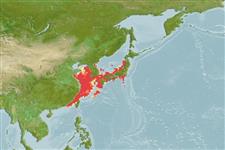Preferred temperature (Ref.
115969): 9.4 - 24.2, mean 16.7 (based on 107 cells).
Phylogenetic diversity index (Ref.
82804): PD
50 = 0.6250 [Uniqueness, from 0.5 = low to 2.0 = high].
Bayesian length-weight: a=0.00891 (0.00811 - 0.00979), b=3.08 (3.05 - 3.11), in cm Total Length, based on LWR estimates for this species (Ref.
93245).
Trophic level (Ref.
69278): 3.7 ±0.4 se; based on diet studies.
Resilience (Ref.
120179): Medium, minimum population doubling time 1.4 - 4.4 years (Tmax=3-23; K=0.2-0.7).
Prior r = 0.70, 95% CL = 0.46 - 1.05, Based on 2 data-limited stock assessments.
Fishing Vulnerability (Ref.
59153): Low to moderate vulnerability (27 of 100).
Climate Vulnerability (Ref.
125649): High to very high vulnerability (70 of 100).
